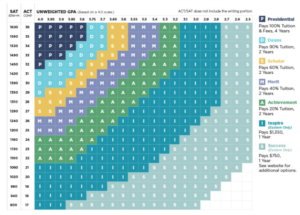
[/media-credit] Utah State University scholarship index.
Thirty-four percent of high school students work a part time job. In Orem, most jobs pay around $10 an hour, $11 if you’re lucky, and $12 if you’re really special. But how can students earn more than that? Or more broadly, what is the most effective use of a student’s time? When appropriately considered, the ubiquitous 10-an-hour job becomes largely overshadowed by more unorthodox ways of earning money, namely saving.
Scholarships have the potential to be one of the most profitable use of a student’s time. Given that roughly 70 percent of graduating seniors are expected to attend college, it is a good idea to be proactive in paying for it. There are two general classifications that scholarships fall into: school funded scholarships, and third party scholarships.
School funded scholarships are given out by the university that a student is attending. These are often judged solely on their ACT/SAT scores, and GPA (True for USU, BYU, UVU, and many more). If this is the case, can we quantify the dollars per hour a student could potentially earn preparing to qualify for these scholarships? While the exact dollar per hour earned could only be exactly calculated in retrospect for an individual student, very rough approximations can be made.
Studying both for school and the ACT elicits diminishing returns, but, for the sake of easy math, let’s assume linear correlations (don’t worry Gilchrist, we won’t extrapolate too far). Let’s assume that increasing hours a week studying causes GPA to increase, and that 10-15 hours a week equates to a 4.0, 5-10 for a 3.0, and 0-5 for a 2.0 or less. For the ACT, let’s assume that 10 hours of study can increase your composite score by 1.
Utah State University’s scholarship rubric shows increasing scholarship money as both ACT and GPA increase. From the inspire scholarship to the success achievement, the average GPA distance is about 0.4, and ACT difference about 5. The difference is $2800. That equates to 50 hours of study on the ACT or two additional hours of study per week, earning 56 and 40 dollars an hour respectively. Using the same method, from achievement to merit, you’d earn about $100 an hour for ACT study, and $71 an hour for additional school study.
Towards the higher end, our estimate has a lower chance of accurately reflecting reality, but let’s do it anyways. Advancing from scholar to deans earns you $222 an hour for ACT study, and $155 an hour for school study. Lastly, from dean to presidential, you would earn $516 an hour for ACT study, and around $350 an hour for school study.
Even if the estimates were off by a factor of 5, studying for either ACT or school would still save you more money than working a job today would earn you. Other factors such as incorporating out-of-state tuition (I used in-state), future loan interest saved, and taxed job income only exaggerate this difference, potentially increasing the dollars per hour by a factor of 3 or 4.
Third party scholarships require a bit less work for the student, and are fortunately a bit easier to compute hard numbers from. Scholarships.com explores a scenario in which a student spends 50 hours applying for scholarships, only to get two or three 1,000 scholarships. That’s still 40-50 dollars an hour. What’s special about applying to scholarships like these, is that it is a linear correlation. Spending another 50 hours applying for more scholarships will, on average, earn you the same amount as the first 50 hours you spent.
As our high school seniors begin applying for colleges, the importance of this topic becomes only more relevant. Despite the difficulty of fully grasping the importance of working hard in school and applying for scholarships, students should find time on a regular basis to improve their academic portfolio, and claim their scholarships. Their very futures depend on it.
Luke Richards
Latest posts by Luke Richards (see all)
- OHS Students React to Assembly - February 7, 2020
- The Best Paying Job - November 1, 2019





